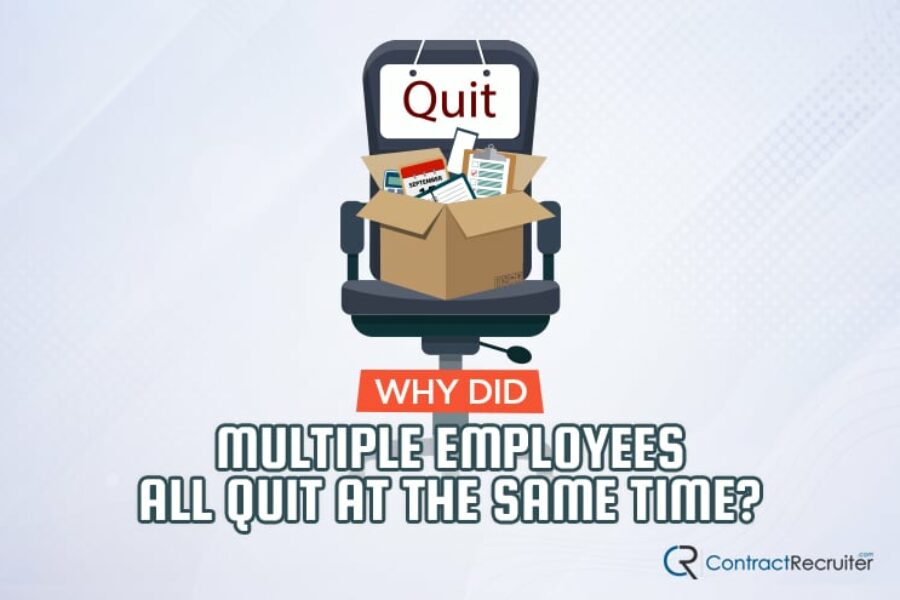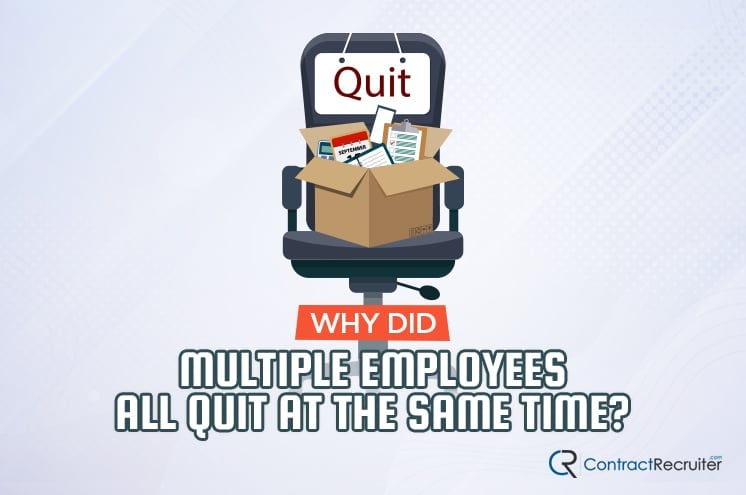

Turnover is a fact of life for a business. Few employees will hold the same position forever; indeed, the idea of a life-long career has been somewhat of a rarity for decades. Even if you have particularly loyal employees, outside factors can lead to a resignation. It’s often outside of your control.
However, there’s a world of difference between natural turnover and a mass exodus of employees. Sometimes, an entire team, department, or group of employees quits all at the same time.
What causes this issue? Can you do anything about it? Let’s dig in.
Understanding Why Employees Leave In Groups
The first step to solving the problem of a mass exodus is understanding why your employees are leaving. Often, the writing is on the wall; you may not want to hear it, or you may have been insulated by a manager hiding the problem, but the signs are generally there. What common causes lead to a mass resignation?
Contagious Dissatisfaction
Humans are social creatures. We build social circles, make friends, and gather in groups. Unfortunately, this can backfire on a company. When an employee decides to leave, it can make others in their social circle – often people they interact with daily, such as their team – consider the same option. They might talk to their friends about why they’re leaving, and recognize “hey, I have those same issues. Why am I staying when they’re leaving?”
Sometimes, this is the simple recognition of ongoing problems in the workplace. Employees simply see their peer leaving as a wake-up call, open their eyes to the toxic situation they’ve been toiling in, and decide that enough is enough.


Other times, employees leaving convince others to come with them. They may get a better offer elsewhere and encourage their new employer to bring their team with them. The reasons and rationales vary, but the effect is the same.
Often, all it takes is a single employee leaving to pull out a pillar of support and send the whole house of cards crumbling.
Key Employees Leave
Similar to contagious dissatisfaction is that there will always be “key” employees. Everyone has a story of a place they worked where the only thing making it tolerable was one good manager or one good team member. When these key “leaders” in the social circle leave, the anchor that kept an entire group around disappears.


This holds true whether the key employee is leaving of their own volition, leaving because of other pressures, or being terminated. Sometimes that key employee is perfectly satisfied with working for you, but other pressures (like a family crisis, a spouse getting a job elsewhere and needing to move, a medical problem, or the like) force them to leave.
When that happens, the employees anchored by that one key individual will reexamine whether or not they want to keep working for you.
Lack of Respect
Employees want to feel respected in their role. They want to be respected, thanked, and encouraged by their peers and bosses. They want to make use of their skills and talents. They want to face challenges suitable to their skill level.


A lack of respect in the workplace, as often as not, leads to turnover. It can be anything from a toxic workplace culture to a single manager who treats their reports as expendable. For example, in this Reddit thread on the subject:
“The boss went off on a tirade on me for something that wasn’t my fault, and I got him to scream, ‘people like you are expendable pieces in this company, and I can replace you tomorrow if I wanted to.’ 80% of the engineers quit the next day. Simply didn’t show up. Including me. From what I know, the entire project folded because my now ex-boss couldn’t find people to replace us because no one wanted to do the kind of work he was looking for at the salary he was paying.”
One individual sent an entire team packing through their behavior and proved why a lack of respect is incredibly damaging.
Problematic Managers, Policies, or Behaviors
Employment is a balance. Very few people are employed in a position they genuinely enjoy or want to work. Most do what they can to make a living and live their lives to their best ability outside of work. When the pressures of work grow too toxic, it becomes better for the mental and physical health of the employee to leave.
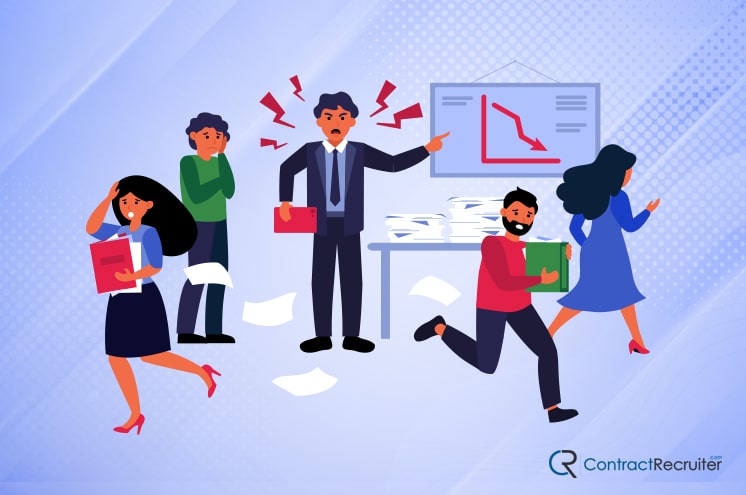

Toxic behaviors can stem from an employee’s peers, managers, or the company itself. A toxic workplace with constant petty sniping, bickering, and backstabbing works against the company as a whole. A bad manager or a toxic set of behaviors from a group of managers is hugely detrimental to everyone beneath them. Toxic and restrictive company policies make growth impossible, so employees have no choice but to leave to see themselves flourish.
Low Pay and Benefits
Sometimes it’s not about culture or respect. Sometimes it’s as simple as money. Everyone needs to make enough money to survive. Inflation goes up, the cost of living rises, yet pay rates are notoriously stagnant across the country in virtually every industry. Remember: every year that an employee doesn’t receive a raise that, at least, equals the increase in the local cost of living and inflation, is a year that employee is effectively making less than they were before.


Sometimes this is a prolonged, low-level pressure that eventually drives employees to leave, so they can earn what they’re worth. Other times, immediate pressures (such as medical bills, property taxes, or other changes) force employees to seek better opportunities.
The fact is, you need to compensate your employees adequately to keep them around. Remember, as well, that “benefits” include more than just salary and health insurance. It can also include things like flexible hours and work/life balance.
Competitor Poaching
While all these pressures can lead one or two employees to leave, many don’t feel comfortable making the jump. This is especially true if they don’t have a polished resume, a connection, or confidence in their skills. Sometimes, though, employees you thought were “safe” have joined others in leaving.


In these cases, a competitor may be poaching your employees. They recognize a flaw in your business – like low pay and benefits, lack of respect, or lack of opportunity – and they promise precisely those things to get your employees to jump ship. It’s not illegal and is a common business practice, and the only thing you can do about it is make your company a better place to work.
External Pressures
Occasionally, other pressures drive employees to leave. They may see the writing on the wall and want to get out of the way of a crisis that would otherwise be devastating to the company.
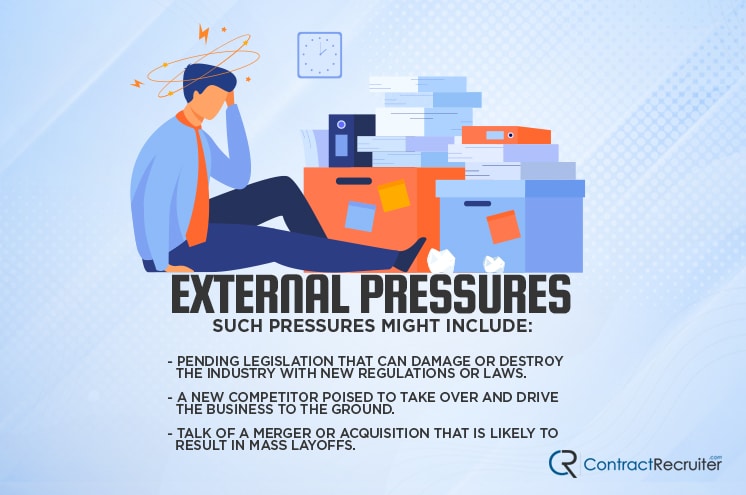

Such pressures might include:
- Pending legislation that can damage or destroy the industry with new regulations or laws.
- A new competitor poised to take over and drive the business to the ground.
- Talk of a merger or acquisition that is likely to result in mass layoffs.
These and similar reasons are often responsible for a mass resignation event that leaves your company in an even worse position to weather the crisis they predicted. Unfortunately, it’s challenging to handle this kind of situation without aggressive change, which many companies aren’t prepared to do.
Identifying the Cause of Mass Resignations
Before you can fight back against a mass exodus, you first need to identify why it’s happening in the first place.
Sometimes, it may be apparent. If many employees are jumping ship when you announce an acquisition, well, you know why they did it. On the other hand, if it’s relatively unexpected, you need to gather information.
One of the best tools in your arsenal for this is the exit interview. Exit interviews can give you a great deal of insight into why employees are choosing to leave, assuming you ask the right questions. That, and your ex-employees need to answer the interview honestly, which isn’t always going to happen, depending on how much perceived power you have over them after they leave.


Talking with your ex-employees can give you some ideas of why they’ve left in a less formal setting as well. Maybe in a casual setting, they’ll be more likely to discuss issues they have with a particular manager, policy, or direction the overall leadership is taking. Again, this can give you a hint at why they’re leaving but might not be as direct as a stated reason.
Unfortunately, the reality is that you will rarely be able to stop a mass resignation. More often, you can attempt to make systemic changes and, occasionally, win back some of those employees. However, most of the time, you need to let those employees go, make your changes, and treat both your remaining employees and your new hires better.
Combatting Mass Resignations
Often, the most challenging part of combating a wave of resignations is admitting that something is wrong. All too often, leadership fails to recognize that there’s a problem until that problem is undeniable and hurting the bottom line. Admitting there’s a problem is the first step to solving that problem.
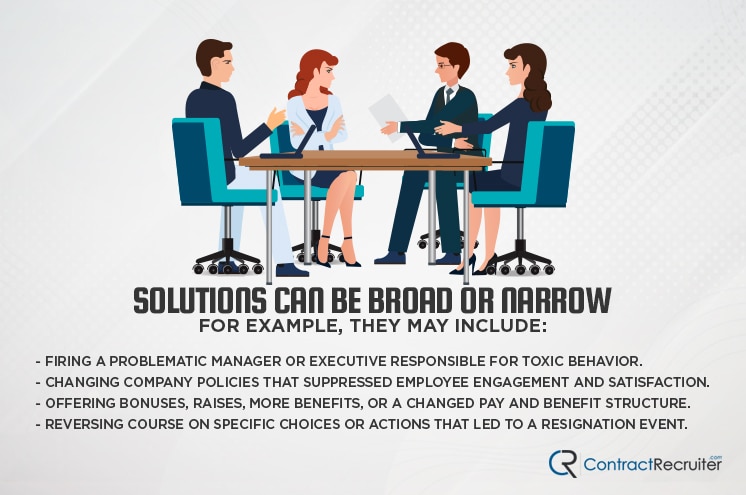

Once you have some idea of why your employees are leaving, you have an opportunity to change and fix the problem.
Solutions can be broad or narrow. For example, they may include:
- Firing a problematic manager or executive responsible for toxic behavior.
- Changing company policies that suppressed employee engagement and satisfaction.
- Offering bonuses, raises, more benefits, or a changed pay and benefit structure.
- Reversing course on specific choices or actions that led to a resignation event.
Sometimes, you don’t have the option to change the cause of a mass exodus. For example, if your company is being acquired and employees are leaving (either due to the acquisition itself or due to which company is acquiring yours), you are very unlikely to be able to pull out of the deal.
On the other hand, sometimes it’s an easy change to make. If firing one manager saves ten employees from leaving, that’s a mathematically simple choice to make. Likewise, when you consider the cost of replacing an employee, increasing pay and benefits can still be cheaper in the long run. Likewise, changing an oppressive company policy is trivially easy to do.
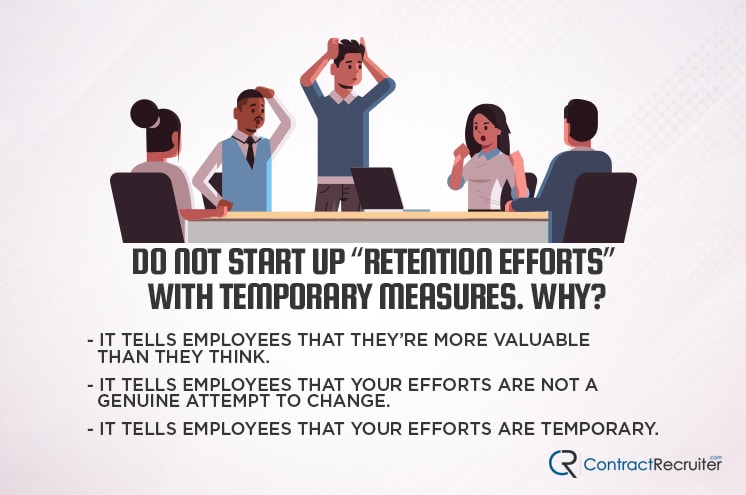

One thing you don’t want to do is start up “retention efforts” with meetings, bonuses, and other temporary measures. Why?
- It tells employees that they’re more valuable than they think, further encouraging them to push for more and/or leave if they don’t get it.
- It tells employees that your efforts are not a genuine attempt to change and are, instead, a bare minimum effort to save the cost of hiring replacements.
- It tells employees that your efforts are temporary, and once the urge to leave has passed, things will go back to the way they were.
Your goal should be to implement broad, overarching changes that have a lasting impact on the problems driving employees to leave.
Additionally, avoid targeting your benefits and changes. If the only people who receive a retention or “loyalty” bonus are the ones thinking of leaving, suddenly everyone will be thinking of leaving; moreover, even if they aren’t really putting out serious applications, they could get a serious offer. Your reaction to an exodus can actually exacerbate the problem. Operate on the assumption that everyone is planning to leave, and you need to take action to keep them around.
It’s generally difficult or impossible to truly stop a mass exodus. The best thing you can do is focus on changing the reasons why your employees are leaving. Then, when you hire their replacements, those replacements won’t face the same problems and pressures that lead to a revolving door of a position.
If you have any questions or concerns regarding mass resignation or how to combat it, please feel free to drop a comment below, and we’ll get a conversation started! We would be more than happy to answer your or your company’s questions on the topic.

